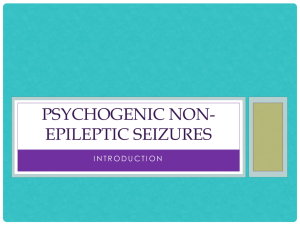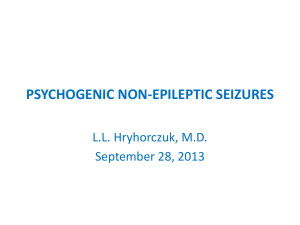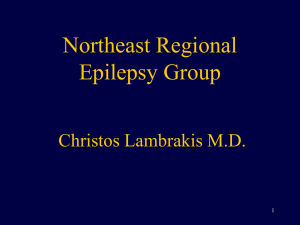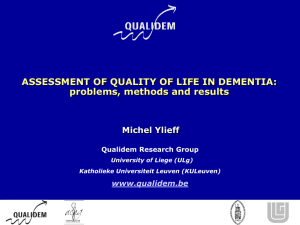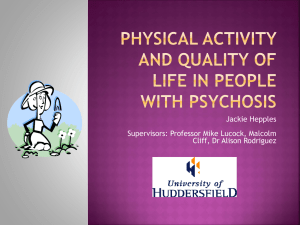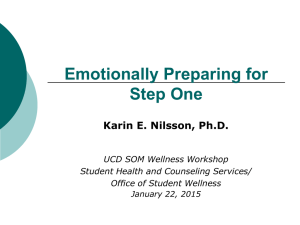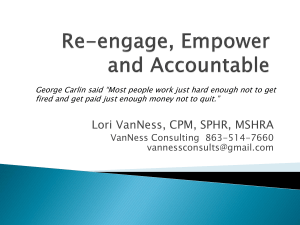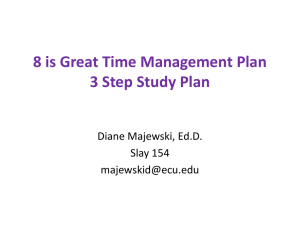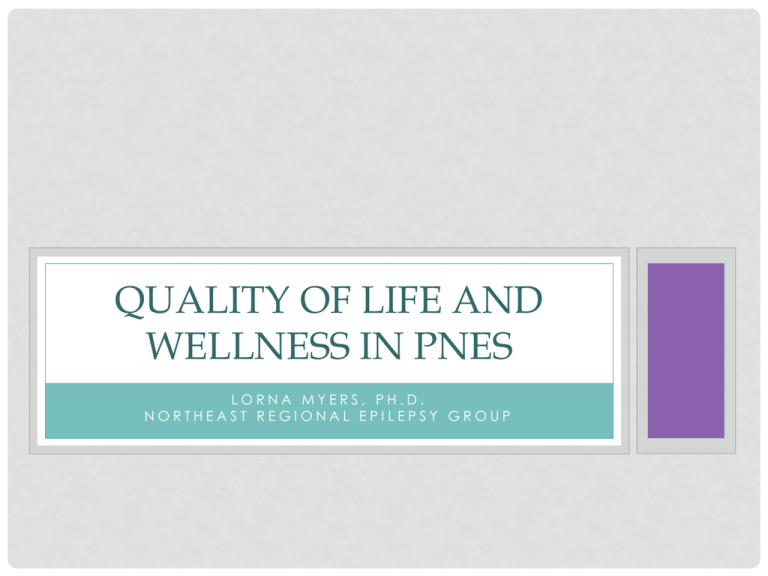
QUALITY OF LIFE AND
WELLNESS IN PNES
LORNA MYERS, PH.D.
NORTHEAST REGIONAL EPILEPSY GROUP
QUALITY OF LIFE: QOL AND HRQOL
• What is QOL? The perceived quality of an
individual’s emotional, physical, and social life.
It is made up of many factors: social economic
conditions, safety, living conditions, health, etc.
• Health problems can obviously affect the
patient’s sense of wellbeing (HRQOL). It is a
subjective assessment of risks, limitations,
functional status (cognitive, emotional, and
physical), support, social economic conditions,
etc.
QOL CAN CHANGE
FOR THE BETTER OR WORSE
QOL AND PNES
• QOL in persons with PNES tends to be
poor.
• QOL in PNES < medically intractable
epilepsy
• WHY do you think this is the case?
WHY IS QOL SO POOR IN PNES?
• Many reasons:
• Seizure disorder: unexpected, intrudes on
life, potentially dangerous, may affect
work/education/social life. Real limitations
and isolation may follow.
• Psychological factors: depression, anxiety,
trauma history and PTSD associated with
PNES.
WHY IS QOL SO POOR IN PNES
• Ignorance and negative attitudes of health
professionals:
• Faking, uncaring and rejecting: drug
seeking, attention seeking.
• Discharge is speedy: “I need this hospital
bed for a patient who is really sick.”
• Often no referrals are given.
• Mental health pros are unfamiliar, often
refuse treatment, doubt diagnosis of PNES
bouncing patients back to neurology.
WHY IS QOL SO POOR IN PNES?
• Ignorance and negative attitudes of family
and friends, bosses, general public:
• This is not a REAL condition, we thought you
had epilepsy. “Get over it, you are not
getting better because you’re weak, you
lack will-power.”
• Overreaction: Unnecessary EMTs and ER
visits with subsequent high medical bills.
• PNES information is not readily available.
Absence of awareness and recognition as a
valid and serious health condition.
WHY IS QOL SO POOR IN PNES
•
•
•
•
•
•
•
Real changes:
Loss of independence
Mobility (i.e. driving)
Sick status
Inactivity
Job?
School?
QUALITY OF LIFE IS A CHOICE TOO
QOL AND SAFETY
• Depends on the characteristics of the episodes.
(paralysis vs. intense motor output vs. drops)
• Educate important people in your life about what
your episodes look like so they can recognize them
and know what to do.
QOL AND SAFETY
• Preventing injuries:
• Pad sharp corners of furniture, bathroom vanities,
etc.
• Thick rugs
• Avoid open flames-use microwave, care when
removing hot objects from oven.
• Avoid steep staircases
• Make sure someone is home when showering, don’t
lock bathroom door, door should open outwards.
• Keep away from side of road or subway/train tracks
SAFETY MEASURES
QOL AND SAFETY
• First Aid: Depends on your episode characteristics
• Zone out: need someone to stay with you until you recover.
• Physically intense: someone needs to make sure you don’t
injure yourself.
• Calling an ambulance is not usually necessary unless you
have injured yourself during episode.
• Carry a laminated card
• Wear medical alerting jewelry: Conversion disorder, seizures
• Cell Phone contact: ICE
SAFETY MEASURES
QOL AND PNES: DRIVING
• If there is a possibility that an episode
while driving can hurt you or another
person, you must not drive
• Driving prohibition laws vary from state
to state
• How to get around? Public
transportation, reliance on others, taxi
wholesale rates, walking.
QOL AND PNES: WORK
• If possible, keep working:
• Accommodations (work from home, time
for doctor visits, avoid being sent out of
town, breaks, perhaps even a leave of
absence).
• If you lose your job, avoid isolation.
Volunteer work, social activities through
your community centers or doctor’s office.
• Disability application
HOW TO IMPROVE QOL?
Avoid social isolation:
Use community resources
Hospital and doctor office wellness programs
Support groups
Become part of a PNES movement (raise
awareness, funds, walks, meetings)
• Take care of yourself:
• Therapy
• Exercise
• Sleep
• Diet
•
•
•
•
•
PNES AND WELLNESS
• Taking care of yourself
• Exercise
• Sleep
• Diet
PNES AND EXERCISE
• Get medical clearance from doctor
before starting a new exercise
regimen
• Choose exercise that is safe given your
episodes
• Choose exercise at your fitness level
• Implement safety guidelines
(automatic stop cord, buddy system)
POTENTIALLY DANGEROUS VS. SAFE
PNES AND EXERCISE
• WHY exercise?
• Improves physical health, stamina, balance,
lowers body fat, etc.
• Reduces anxiety, depression, tension,
fatigue
• Burns stress hormones and encourages
production of endorphins - “well being
hormones”
• Sense of accomplishment
TYPES OF EXERCISE
• Brisk walking
• Moderate jogging
• Cycling on stationary bike
• Core muscle building
• Tai chi
• Yoga
• Zumba
• Gardening
• Martial arts
PNES AND SLEEP
• Poor sleep depression and anxiety
• Poor sleep:
•
•
•
•
•
•
•
•
Poor concentration
Irritability
Increased risk of accidents
Weak immune system
Weight gain
Premature aging
Cardiac problems
Dependence on caffeine and sleep aids
PNES AND SLEEP
• Do’s
• Figure out how many hours you need
• Try to go to bed and wake at the same
time
• Keep room dark and cool (65-72 F
degrees)
• Make sure mattress and pillows are
comfortable
• Use bed only for sex and sleep
•
PNES AND SLEEP
• Don’t
• Eat heavy meals or drink a lot of fluids right before
sleep
• Use alcohol to induce sleep
• Drink caffeine in the evening
• Take naps if possible
• If you can’t sleep, don’t stay in bed more than 30
minutes
GOAL: PEACEFUL SLEEP
PNES AND DIET
• High quality fuel helps your mind and body run
better.
• Check with your doctor and/or nutritionist.
• Do:
• Eat a balanced diet: fresh vegetables, fruits, lean
protein
• 5-6 meals a day-breakfast is important
• Eat as soon as you feel hungry or have signs of low
blood sugar
• Keep yourself hydrated (water is best)
PNES AND DIET
• Avoid:
• Foods high in sugar or refined carbohydrates
(cakes, cookies, white bread)
• Fasting, skipping meals, or following extreme
restrictive diets
• Caffeine as much as possible
• Alcohol as much as possible
• Rushing while eating
HEALTHY DIET
TAKE HOME MESSAGE
• QOL in PNES is definitely affected but you
can improve your QOL in a number of ways
• 1) Participating in psychological treatment
regularly and actively
• 2) Taking care of yourself
• Exercise
• Sleep
• Diet
TAKE HOME MESSAGE
• 3) Avoiding social isolation:
• Use community resources
• Use hospital and doctor’s office wellness
programs
• Support groups
• Become part of a PNES movement (raising
awareness, funds, walks, meetings)
• Use social media and the internet
• Website: www.nonepilepticseizures.com
• Facebook: Psychological non epileptic
seizures
TAKE HOME MESSAGE
4) Owning the condition of PNES.
• It is very important that you educate yourself and
others about PNES. Knowledge is Power.
• Psychogenic Non-epileptic Seizures: A Guide
available on Amazon Chapters 8 and 9
• 5) Continue working toward a positive future:
• www.epilepsyfree.com for continuing education
scholarships and funds for educational programs
SAMPLE OF OUR COMMUNITY
ACTIVITIES
SAMPLE OF OUR COMMUNITY
ACTIVITIES
THANK YOU!
•Let’s stay in touch
•lmyers@epilepsygroup.co
m

